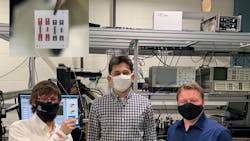USAF Researchers Shrink RF Isolators
The continuing quest to reduce size, weight, and power (SWaP) in electronic systems is often a challenge when it comes to certain passive components such as attenuators and filters, which are typically constructed from materials that do not lend themselves to miniaturization. But researchers at the U.S. Air Force Research Laboratory (AFRL) recently discovered how to produce an often-used high-frequency passive component, the RF isolator, in a size akin to that of semiconductor devices. RF isolators are vital for minimizing unwanted signal reflections in systems operating at microwave and mmWave frequencies.
The AFRL research team of Dr. Derek A. Bas, Dr. Piyush J. Shah, and Dr. Michael R. Page (left to right; Dr. Bas's tweezers hold a chip with an array of four RF isolators) developed an isolator that is approximately one-sixth the size of miniature RF isolators based on currently available magnetic materials, such as yttrium-indium-garnet (YIG) materials, which also consume higher amounts of power. The same research team previously applied their design strategy to develop a patented tunable filter to replace the much larger YIG-tuned filters commonly used in high-frequency systems and test equipment.
The researchers used a layer of piezoelectric material along with a thin film of permanently magnetized material to achieve high isolation from a chip-sized passive component. As Dr. Page reports, “The novel device in our work is essentially an RF isolator.” Dr. Shah adds: “The core area of the science of our technology is called acoustically driven ferromagnetic resonance phenomena.” Research in this area of replacing larger ferromagnetic components with lower-power composites of magnetic and piezoelectric materials, which was begun by German scientists, has been ongoing for about a decade. Their team has reported isolation of close to 50 dB for the tiny components, a significant improvement over earlier isolators fabricated on the composite materials. As Shah notes, the high isolation translates into minimal signal reflections in high-frequency circuits and systems: “In our device, the signal is essentially completely blocked when returning or reflected in the opposite direction.” The AFRL team is pursuing the research with Sandia National Laboratories in quest of a circulator based on the same material.
About the Author
Jack Browne
Technical Contributor
Jack Browne, Technical Contributor, has worked in technical publishing for over 30 years. He managed the content and production of three technical journals while at the American Institute of Physics, including Medical Physics and the Journal of Vacuum Science & Technology. He has been a Publisher and Editor for Penton Media, started the firm’s Wireless Symposium & Exhibition trade show in 1993, and currently serves as Technical Contributor for that company's Microwaves & RF magazine. Browne, who holds a BS in Mathematics from City College of New York and BA degrees in English and Philosophy from Fordham University, is a member of the IEEE.
